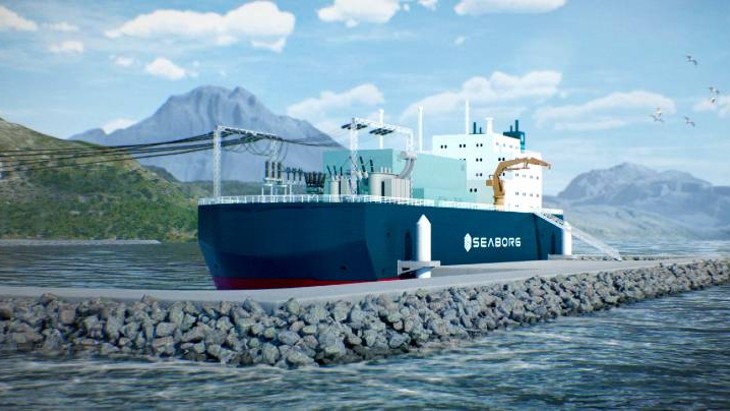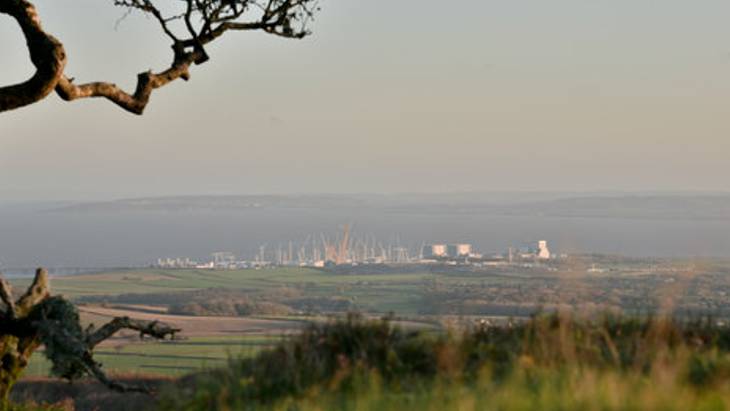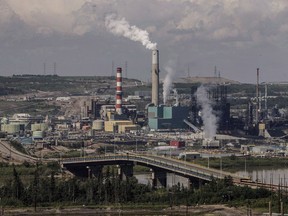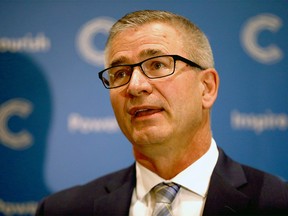NUKE NEWS
Canadian waste organisation completes borehole programme
08 April 2022
Canada's Nuclear Waste Management Organization (NWMO) has completed its deep borehole drilling programme to understand the subsurface geology in the two areas that will potentially host a deep geological repository for the nation's used nuclear fuel. The programme will help inform the final selection of a site.
.jpg?ext=.jpg) A geoscientist examines core samples extracted from bedrock in South Bruce (Image: NWMO)
A geoscientist examines core samples extracted from bedrock in South Bruce (Image: NWMO)
The NWMO is charged with implementing Canada's plan for the safe, long-term management of used fuel, known as Adaptive Phased Management, and launched the site selection process in 2010. The selected site must have the support of "informed and willing" hosts and NWMO is working to ensure that the chosen location will be safe and secure.
By 2012, 22 communities had expressed an interest in learning about the project and exploring their potential to host it. Eleven of those communities went forward to the second phase of the NWMO's preliminary assessment process. By the end of 2019, the list of potential host communities had been narrowed down to two: one in the Wabigoon-Ignace area and the other in the Saugeen Ojibway Nation (SON)-South Bruce area. Both locations are in Ontario.
Drilling and testing of boreholes to depths of up to 1000 metres below the surface advances understanding of the subsurface geology in a study area and helps ensure the site will meet regulatory requirements. The process involves making a small diameter hole using drilling equipment and retrieving cylinder-shaped rock samples called core.
Drilling of two boreholes at SON-South Bruce began in April last year. Drilling of six boreholes at Wabigoon-Ignace - where work began on the first borehole in 2017 - was completed in November 2021, following a suspension during the COVID-19 pandemic.
NWMO has now announced the completion of the last borehole at the SON-South Bruce potential site, bringing to an end some five years of intensive field studies during which about 8 km of bedrock samples have been recovered from the two locations.
Deep geological repositories are internationally recognised as the safest way to manage used nuclear fuel over the very long term, NWMO Vice-President of Site Selection Lise Morton said. "Completion of this drilling programme is a significant step forward in our geoscience work. In addition to informing the safety case for the project, the resulting data will also provide important insights to the communities that are considering hosting the project in their area," she added.
Once the site has been selected, detailed site characterisation, federal impact assessment and licensing processes will begin. NWMO said it remains on track to complete the site selection in 2023. Construction of the repository is currently anticipated to begin in 2033, with operations beginning between 2040 and 2045.
Canadian companies collaborate to advance nuclear technology
07 April 2022
Bruce Power and Ontario Power Generation (OPG) have agreed to work together to support new nuclear technologies in Ontario. Building from shared experiences with their existing Candu fleets, the companies plan to collaborate on regulatory strategies and other enablers for a new nuclear fleet, as well as evaluating potential opportunities for the future deployment of small modular reactors (SMRs) and other new nuclear technologies.
.jpg?ext=.jpg) Working together to advance nuclear technology: OPG President and CEO Ken Hartwick (second from left) and Bruce Power President and CEO Mike Rencheck (far right) pictured with Canadian Nuclear Association President and CEO John Gorman (far left) and Ontario Minister of Energy Todd Smith (second from right) (Image: Bruce Power)
Working together to advance nuclear technology: OPG President and CEO Ken Hartwick (second from left) and Bruce Power President and CEO Mike Rencheck (far right) pictured with Canadian Nuclear Association President and CEO John Gorman (far left) and Ontario Minister of Energy Todd Smith (second from right) (Image: Bruce Power)
Ontario's Candus already provide about 60% of the province's clean electricity, and thanks to major projects by both companies, will continue to underpin Ontario's electricity system for decades to come. The shared experience of operating and refurbishing their Candu reactors has positioned OPG and Bruce Power to coordinate their efforts in expanding the role of nuclear power in the fight against climate change by evaluating technology options, promoting regulatory efficiencies, and developing strategies to best meet the needs of ratepayers in Ontario, they said yesterday.
OPG is over half-way through a CAD12.8 billion (USD10.1 billion) project to refurbish the four Candu units at Darlington that will enable the power station to operate for an additional 30 years. Bruce began refurbishment of the first of six of its nuclear units in 2020 as part of an overall life extension plan that began in 2016. In addition, the Darlington New Nuclear Project aims to deploy a BWRX-300 SMR at Darlington by the end of this decade. OPG has said it is preparing to submit its application for a construction licence by the end of this year.
The newly announced collaboration with Bruce Power will help advance new nuclear options for the long-term production of clean energy in Ontario and Canada, said OPG Executive Vice-President, Business Strategy and Commercial Management Chris Ginther: "We believe the Darlington New Nuclear Project is the first of many new nuclear opportunities that will need to be advanced as we make critical steps towards a net-zero future."
"Bruce Power is strongly supportive of OPG's SMR Project at Darlington and is looking forward to expanding our long-standing collaboration with OPG to advance new nuclear technology more broadly to create economic opportunities for the province, support innovation and to meet future energy needs while achieving net-zero," said James Scongack, Bruce Power's chief development officer and executive vice-president, Operational Services.
Microreactors are one of the three development streams identified in a joint strategic plan setting out a path for developing and deploying SMRs released by the governments of Ontario, Saskatchewan, New Brunswick and Alberta in March, and Bruce in 2020 agreed with Westinghouse Electric Company to pursue applications of Westinghouse's eVinci microreactor within Canada.
Samsung, Seaborg partnership on floating nuclear reactors
08 April 2
The Memorandum of Understanding is to manufacture and sell turnkey power plants combining Samsung Heavy Industry’s ship-building expertise and the Danish company’s Compact Molten Salt Reactor (CMSR). It also covers development of hydrogen production plants and ammonia plants.
 How a 200 MWe Power Barge could look (Image: Seaborg)
How a 200 MWe Power Barge could look (Image: Seaborg)
Seaborg’s design is for modular CMSR power barges that can produce between 200 MW and 800 MW of electricity, with an operational life of 24 years. Instead of having solid fuel rods that need constant cooling, the CMSR’s fuel is mixed in a liquid salt that acts as a coolant, which means that it will simply shut down and solidify in case of emergency.
Jin-Taek Jeong, president and CEO of Samsung Heavy Industries, said: "CMSR is a carbon-free energy source that can efficiently respond to climate change issues and is a next-generation technology that meets the vision of Samsung Heavy Industries.
"Through this agreement, we plan to pioneer the CMSR-based floating nuclear power plant market as part of strengthening its future new business opportunity."
The partnership agreement was signed at an online event, with Seaborg CEO and co-founder Troels Schönfeldt saying: "We are honoured and proud to have formed this partnership with Samsung Heavy Industries, one of the world’s largest and most experienced shipyards. It is another step forward in our quest to introduce a new generation of nuclear reactors that are clean and safe and can be built using industrial technology with all the benefits of scalability, speed, and lower costs." The signing of the partnership agreement took place on 7 April (Image: Samsung Heavy Industries)
The signing of the partnership agreement took place on 7 April (Image: Samsung Heavy Industries)
The timeline for Seaborg, which was founded in 2014, has been for commercial prototypes to be built in 2024 with commercial production of Power Barges beginning from 2026.
Samsung Heavy Industries signed an agreement in June last year with the Korea Atomic Energy Research Institute for offshore molten-salt-cooled reactors development and research.
AP1000 remains attractive option for US market, says MIT
08 April 2022
An overnight capital cost of USD2900 per kilowatt for the next AP1000 series in the USA is achievable, according to an independent assessment by the Massachusetts Institute of Technology's Center for Advanced Nuclear Energy Systems. The report considers the cost in the context of the experience realised at the Vogtle site in Georgia, where two AP1000 units are under construction.
.jpg?ext=.jpg) Vogtle units 3 and 4, pictured in January (Image: Georgia Power)
Vogtle units 3 and 4, pictured in January (Image: Georgia Power)The delays and cost overruns faced by the Vogtle AP1000 project have "decimated US energy utilities' interest in large nuclear power plant construction projects. The general energy sector also utilises the experience at Vogtle as an indicator of nuclear energy's high cost and infeasibility of the role it can play in future energy markets," the report notes. It says several unique project parameters have led to the inflation of the Vogtle total project cost (currently standing at USD28 billion), including high interest rates, lack of detailed design prior to start of construction, construction management turnover and first-of-a-kind (FOAK) issues.
Construction of the two Vogtle AP1000 units began in 2013: unit 3 in March and unit 4 in November. Southern Nuclear and Georgia Power, both subsidiaries of Southern Company, took over management of the project to build the units in 2017 following Westinghouse's Chapter 11 bankruptcy. Vogtle unit 3 is now expected to be in service by the end of the first quarter of 2023, with unit 4 following by the fourth quarter of 2023.
Four Westinghouse AP1000 reactors are already in commercial operation at Haiyang and Sanmen in China.
"Almost 10 years after the start of construction in the US, the AP1000 is now a proven technology with four operating plants in China," MIT said. "The next AP1000 plant has potential to provide a viable product in the US and oversees if its original nth-of-a-kind (NOAK) capital cost and construction schedule projections by Westinghouse can be realised."
The 'should cost' decouples the impact of cost by competency of the reactor vendor, supply chain logic and construction execution from the design architecture, the report said. It is also essential to ensure comparison of like costs (FOAK or NOAK) when evaluating future technology selections, in recognition that most publicised costs are NOAK exclusive of owner's and financing costs.
MIT estimates the overnight capital cost for Vogtle 3 and 4 at USD7956/kW. It says the 'should cost' of the next AP1000 overnight capital cost in the USA to be USD4300/kW and USD2900/kW for the following 10th unit (online by around 2045), deployed in series, based on 2018 dollars.
"Contrary to perhaps the consensus verdict among US utilities, the AP1000 NOAK estimated overnight capital cost, which still requires large capital investment to realise, continues to make AP1000 an attractive option for nuclear energy development globally," it said. Globally, while some one-time FOAK issues will be reintroduced, "the lower labour rates, owner's costs and indirect costs relative to the US, can make AP1000 an affordable technology for displacing existing carbon emitting power plants."
The report says constructing more than 10 reactors consecutively allows achieving low costs for the direct portion of the capital cost (minimises rework), but particularly reduces indirect cost (sharing of engineering and management experience among units).
Competitive with SMRs
The study includes a comparison of the AP1000 technology relative to other near-term nuclear technologies, including large light-water reactors (LWRs) and small modular reactors (SMRs).
The AP1000 is an attractive technology for large scale decarbonisation, MIT said, since it "features a compact design in terms of amount of concrete and steel used per MWe generated compared to leading large LWRs and SMRs (i.e., lowest direct 'should cost') while still generating more than 1000 MWe of carbon free electricity (i.e., low O&M cost)."
It said overnight costs per kWe of SMRs are estimated to be 1.4-1.75 times the cost of the next AP1000 plant "because of the lack of economy of scale".
According to MIT, "SMRs are an attractive option for certain markets where small additional capacity of carbon free energy is needed. However, if multiple SMRs are housed in a single reactor building (e.g., NuScale), then no measurable reduction in overall onsite labour input compared to AP1000 is expected and the capital cost will be higher than a large reactor due to the large volume of concrete and steel per MWe produced."
EDF looks to extend Sizewell B operation
07 April 2022
EDF Energy is leading a Long-Term Operation (LTO) programme aimed at extending the operating lifespan of Sizewell B - the UK's only pressurised water reactor and newest nuclear power plant - by at least 20 years to 2055.
_1.jpg?ext=.jpg) The Sizewell B plant in Suffolk, England (Image: EDF)
The Sizewell B plant in Suffolk, England (Image: EDF)
Sizewell B entered commercial operation in February 1995 and is currently expected to be in operation until 2035. By 2028, the 1198 MWe reactor will be the only operating nuclear power plant from the UK's existing fleet.
General Electric, Jacobs and Westinghouse have been selected by EDF to support the preliminary life extension work at Sizewell B.
"This is the start of a robust process which will involve key partners including Westinghouse, Jacobs, GE and Framatome, some of which were involved at the start of the station's operation," EDF Energy said.
The first phase of the LTO programme includes scoping and cost-benefit analysis. EDF Energy estimates the value of this phase at GBP10 million (USD14 million) to all participants.
Sizewell B will engage with industry regulators the Office for Nuclear Regulation and the Environment Agency throughout the process. Equipment will be systematically checked and the plant and partners will identify the areas where investment will be required to maintain safe and reliable generation, should the decision be taken to extend its operation to 2055.
EDF said it will make a final decision in 2024, which would then be followed by the required capital investment in the plant, safety enhancements and obtaining the necessary approvals.
"This collaboration, between Jacobs, General Electric, Westinghouse and EDF brings together the original equipment manufacturer/architect engineer organisations from the design and construction of Sizewell B in the 1990s," noted Jacobs Energy Security & Technology Senior Vice President Karen Wiemelt. "Jacobs has worked at the station since initial construction and, along with our partners, we bring intrinsic knowledge and experience of plant life extension to the LTO programme, which will help safeguard the future of a vital part of the UK's clean energy infrastructure."
"We are very proud to join Jacobs and General Electric on this key project to extend Sizewell B's operational lifetime which, in turn, will support the UK's economic growth and job market, providing a safe path to a clean energy future," said Tarik Choho, Westinghouse President, EMEA Operating Plant Services.
EDF Energy Chief Nuclear Officer Paul Morton said: "Sizewell B power station is an important national asset that helps deliver clean, independent energy supplies."
UK planning for rapid nuclear expansion
07 April 2022
The Energy Security Strategy's ambitions are for eight new reactors, plus small modular reactors, helping to produce 24 GWe capacity by 2050, representing about 25% of the UK's projected electricity demand.
 Hinkley Point C will be the first new nuclear plant in the UK this century (Image: EDF)
Hinkley Point C will be the first new nuclear plant in the UK this century (Image: EDF)
Nuclear's share of energy in the UK is currently about 16%, however almost half of the country's current capacity is due to be retired by 2025 and all but one of its reactors will retire by 2030.
A new government body, Great British Nuclear, is being set up to bring forward new nuclear projects at a rate of about one a year this decade, including the Wylfa site in Anglesey, the strategy says.
UK Prime Minister Boris Johnson said: "We’re setting out bold plans to scale up and accelerate affordable, clear and secure energy made in Britain, for Britain - from new nuclear to offshore wind - in the decade ahead.
"This will reduce our dependence on power sources exposed to volatile international prices we cannot control, so we can enjoy greater energy self-sufficiency with cheaper bills."
.jpg)
UK operable nuclear power capacity, 1970-2022 (Image: World Nuclear Association)
As well as the expansion of nuclear, the strategy also includes a large increase in offshore wind - up to 50 GWe or enough to power every home in the UK, plus 5 GWe from floating offshore wind in deeper seas. Planning rule changes are also proposed to cut approval times from four years to one year.
However, amid reports of differences within Johnson’s Conservative Party about onshore wind, the strategy commits only to "consulting on developing partnerships with … communities who wish to host onshore wind infrastructure in return for guaranteed lower energy bills".
There will also be a licensing round for new North Sea oil and gas projects "recognising the importance of these fuels to the transition and to our energy security, and that producing gas in the UK has a lower carbon footprint than imported from abroad".
And on solar power the ambition is to increase the current 14 GWe capacity by five times by 2035, with possible changes in the rules governing solar projects on rooftops. There is a doubling of the ambition to 10 GWe of low carbon hydrogen production capacity, "with at least half coming from green hydrogen and utilising excess offshore wind power to bring costs down".
UK Business and Energy Secretary Kwasi Kwarteng said: "The simple truth is that the more cheap, clean power we generate within our borders, the less exposed we will be to eye watering fossil fuel prices set by global markets we can’t control.
"Scaling up cheap renewables and new nuclear, while maximising North Sea production is the best and only way to ensure our energy independence over the coming years."
The UK currently has one nuclear power station under construction, at Hinkley Point C in Somerset in south west England. Construction began in December 2018 for the plant which is composed of two EPR reactors of 1630 MWe each. The start of electricity generation from unit 1 is expected in June 2026, with unit 2 following in 2027 with a projected lifespan of 60 years. Negotiations between the government and EDF are on-going for a replica project of Hinkley Point C at Sizewell C in Suffolk in eastern England. There is also a project under way to extend the life of Sizewell B by 20 years to 2055.
Reaction - in quotes
Commenting on the new strategy, World Nuclear Association Director General Sama Bilbao y León said: "Governments across the world should be following the UK's example and setting out policies that put nuclear as an essential and substantial component of their long term energy strategies.
"With widespread agreement that nuclear has a key role to play in delivering a clean, affordable and secure energy mix it is vital that governments, industry and other key stakeholders work together to ensure we not only set out ambitious plans, but also deliver on them."
The energy strategy was welcomed by those involved in the nuclear industry in the UK, with EDF’s UK CEO Simone Rossi saying that "building more new nuclear will reduce Britain’s dependence on overseas gas and keep energy prices stable, creating thousands of jobs while we’re doing it".
"At Hinkley Point C we’re already building British nuclear, with 3600 British businesses and 22,000 people making it happen, including over 800 apprentices. The fastest way to get more nuclear in Britain is get on with the next two units at Sizewell C. It’s a copy of Hinkley Point C, the design is approved and ready to go, and British manufacturers are experts in how to build it. Building more of the same design is the best way to bring down costs and develop a strong UK supply chain."
Tom Greatrex, CEO of the UK Nuclear Industry Association, called the new nuclear target a "vital step forward for UK energy security and our net zero future".
He said: "This investment will also create tens of thousands of jobs across the country and revitalise a world class skills base right here in Britain. The ambition and determination to do much more and quicker is very welcome.
"Along with removing barriers to projects getting started, building investor confidence by ensuring nuclear is classified as green in the UK taxonomy and making it eligible for green bonds are important next steps. We also want to see the money from the promised Future Nuclear Enabling Fund allocated at pace, with good sites being made available for project development."
Dawn James, vice president Nuclear Power, for Jacobs said: "We are working on Hinkley Point C, on the Rolls-Royce Small Modular Reactor, on Urenco’s U-Battery micro reactor, and on nuclear fusion. We believe that large scale reactors, small modular reactors and fusion power will play a crucial part in reducing our dependency on fossil fuels and we are working to ensure that the UK is at the forefront of developing them."
Chris Ball, Managing Director, Nuclear & Power EMEA at Atkins, said: "Strengthening security of supply means creating a resilient energy system, fuelled by a mix of low-carbon technologies and renewable sources without dependence on any one fuel or region. The Energy Security Strategy unveiled by the UK government today will go some way towards achieving this in the medium to long-term."
He added, "Our sector has a major role to play in engineering net-zero and ensuring a viable plan is created to deliver secure and clean energy supplies that will power the UK's net-zero economy. We look forward to working with government and across the industry to ensure these ambitions translate into a successful and efficient energy system."
Sharon Graham, the general secretary of the UK’s largest union for energy workers, Unite, said: "It has taken a war and a global crisis to get this government to act on the long-standing and vitally important issue of meeting the energy needs of the country and the planet. This is something we have been pushing for years.
"Now we have promises of investment and new jobs. But the devil will be in the detail. Government investment must be tied to UK job guarantees and not be syphoned off to boost offshore profits. There can be no further delays on delivering the new jobs and they must be union jobs, covered by collective bargaining, good pay, terms and conditions."
Tom Samson, CEO of Rolls-Royce SMR, said: "The Rolls-Royce SMR remains the fastest route to market for new nuclear deployment in the UK and we welcome this government’s clear commitment to turbocharging nuclear deployment.Rolls-Royce SMRs offer an affordable, sustainable and secure low-carbon future for the UK and an export opportunity to realise the aims of Global Britain if we act now."
George Borovas, head of Hunton Andrew Kurth's nuclear practice, said: "It is great to see that the UK’s Energy Security Strategy has recognised the importance of giving nuclear energy a central role in the country’s future energy mix. Not only will this contribute to meeting net-zero goals, but it will also secure the UK’s energy independence in the long-term alongside investments in wind, hydro and solar power."
"The events in Ukraine have underscored the need for energy independence in the UK. New nuclear ticks all the boxes for a self-reliant UK as it is carbon-free, will re-purpose existing 'brownfields' sites, and will play a key role for the developing hydrogen economy," said Vince Zabielski, Partner at international law firm Pillsbury. "Kudos to the UK government for a return to rational thinking as regards energy policy."
On the overall strategy, the opposition Labour Party criticised the lack of targets for onshore wind power, saying that there was nothing in the energy strategy to provide help with soaring energy bills in the near future and no support for energy efficiency and reducing demand for energy. And EOn UK's CEO, Michael Lewis, said that "by abandoning any extra commitment to helping people to improve their homes, today’s announcement condemns thousands more customers to living in cold and draughty homes, wasting energy and paying more than they need to for their heating".
Tennessee site selected for advanced reactor fuel facility
06 April 2022
UPDATED: A site in Oak Ridge, Tennessee has been selected as the site for the USA's first commercial high-assay low-enriched uranium (HALEU)-based fuel fabrication facility. Construction of the TRISO-X Fuel Fabrication Facility, or TF3, is to begin this year, with commissioning and start-up as soon as 2025. The company has submitted a licence application to the US Nuclear Regulatory Commission (NRC).
.jpg?ext=.jpg) Artist rendering of TRISO-X's proposed headquarters and commercial fuel facility at the Horizon Center Industrial Park (Image: X-energy)
Artist rendering of TRISO-X's proposed headquarters and commercial fuel facility at the Horizon Center Industrial Park (Image: X-energy)
Xe-100 developer X-energy announced on 4 April that its wholly-owned subsidiary, TRISO-X LLC, has selected the Horizon Center Industrial Park in Oak Ridge to site the plant, which will initially produce 8 tonnes of fuel per year - enough to support about twelve Xe-100 small modular reactors.
The commercial facility’s cross-cutting design will enable manufacturing of fuel for any number of advanced or small nuclear reactors based on TRISO fuel, the company said.
TRISO - tristructural isotropic - fuel particles consist of a "kernel" of uranium oxycarbide (or uranium dioxide), surrounded by layers of carbon and silicon carbide, giving a containment for fission products which is stable up to very high temperatures. Fuel for X-energy's Xe-100 high temperature gas-cooled modular reactor consists of spherical "pebbles" each embedded with 18,000 TRISO particles. Each fuel pebble is about the size of a billiard ball - around 6cm in diameter.
TF3 will be a first-of-a-kind US Nuclear Regulatory Commission (NRC) Category II-licensed TRISO-based fuel fabrication facility, X-energy said. It will utilise uranium enriched to less than 20% uranium-235 to manufacture nuclear fuel products for a variety of advanced and small modular reactors, plus speciality fuels for space nuclear projects. TRISO-X aims to expand the facility's capacity from its initial 8 tonnes per year to 16 tonnes year by the early 2030s.
In October 2020, the US Department of Energy selected X-energy as one of two recipients to receive funding under its Advanced Reactor Demonstration Program (ARDP) to build a demonstration plant that can be operational within seven years. Under the project, X-energy is to deliver a commercial four-unit power plant based on the Xe-100, as well as a commercial-scale TRISO fuel fabrication facility. In April 2021, Energy Northwest, Grant County Public Utility District and X-energy formed the Tri-Energy Partnership to construct a plant based on the Xe-100 design at Energy Northwest's existing Columbia nuclear site in Washington state.
"The Department of Energy calls TRISO the most robust nuclear fuel on Earth," TRISO-X President Pete Pappano said. "TRISO is a technology that's been developed and improved over 60 years. Our facility will bring this game-changing fuel to market, beginning with a proprietary spherical fuel pebble for X-energy's Xe-100 reactor and its utility partner Grant County Public Utility District, in Washington state."
.jpg.aspx)
The TRISO-X Pilot Facility, already operating at Oak Ridge National Laboratory via a public-private partnership, produces kilogram quantities of HALEU fuel (Image: X-energy)
TF3 will also be used to continue to support government funded projects, such as mobile reactors for the military or space nuclear projects, Pappano added. TRISO-X is already operating two facilities at Oak Ridge: the TRISO-X Pilot Facility, located inside Oak Ridge National Laboratory, and the TRISO-X Research and Development Center in the Centrus Technology Manufacturing Center. TF3 is projected to generate more than 400 jobs in the Oak Ridge area and attract some USD300 million of investment.
Licensing review
TRISO-X submitted its licence application - the first-of-a-kind for a facility dedicated exclusively to handling and processing uranium of such enrichment - to the NRC on 6 April. The licence application took about three years to develop, at a cost of almost USD20 million, and the NRC's review process is expected to take 24-36 months. TF3 would become the first 10 CFR 70 Category II licensed fuel facility in the USA.
.jpg.aspx)
TRISO-X Director of Regulatory Affairs Jennifer Wheeler presents the licensing application to NRC Licensing Project Manager Matthew Bartlett, watched by representatives from ADRP, NRC and TRISO-X (Image: X-energy)
The NRC review, and TRISO-X's interactions with the regulator over this period, are part of X-energy's cooperative agreement with ARDP. Andrew Griffith, US acting assistant secretary for Nuclear Energy, said the licensing milestone is "a critical step" towards achieving the programme's goals.
Researched and written by World Nuclear News







 Save Old Growth protesters blocked Highway 1 Friday morning (April 8), calling on an immediate end to old-growth logging in B.C.Save Old Growth
Save Old Growth protesters blocked Highway 1 Friday morning (April 8), calling on an immediate end to old-growth logging in B.C.Save Old Growth






